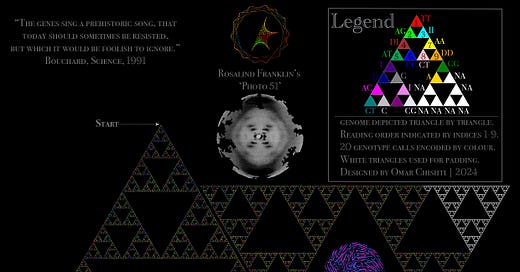This piece depicts the first chromosome of my genome sequence as a pair of mirrored Sierpiński triangles. It is the third and final part of the MAD triptych (Music-Astronomy-DNA), with shared musical/celestial/geometric themes.
Raw genotype data from a 23andMe test I took at some point in early 2023 was used to generate this piece. Each row in the raw data table corresponds to an SNP (single nucleotide polymorphism). For each SNP, the data provides its identifier (an rsID or an internal id), its position on the reference human genome, and the genotype call oriented with respect to the plus strand (direction 5'->3', also called the sense strand) on the human reference sequence. Reference human assembly build 37 (also known as Annotation Release 104) was used for my genome. The raw data was cleaned programmatically, and a colour was assigned to each of the 20 distinct genotype calls.
These calls are marked in the legend with coloured labels (either a single letter or two letters) and triangles. I also attempt to indicate the geometric framework of the composition using the indices, which should reveal how the sequential rows get arranged into the pyramidal structure. Perhaps my childhood fondnesses for Toblerone and for building houses of cards helped inspire this result. The fractal Sierpinsky triangle was generated using Python code I wrote for that purpose. I generated a separate fractal triangle for each chromosome. Each constituent genotype call at SNP loci is thus encoded by one of the aforementioned coloured constituent triangular units. I also played around with using different fractal shapes (such as the Koch snowflake) for different chromosomes.
I include a helpful depiction of the way the recursion manifests in the visual using these magnified sections. The white padding (triangles labelled NA) in the legend was necessary since the number of SNPs per chromosome do not line up with the number that make a compete fractal of the corresponding level.
A subsidiary legend in the bottom left marks which chromosome the data is from. I’m tempted to complete the series, but there are so many other things to complete first.
This visual is an attempt to paint with thought, to connect the beauty of emergent geometry with fundamental genetics. Different conformation forms of DNA are included in the margins, as is the X-ray crystallography image from Rosalind Franklin which was the key to understanding its double helical structure. The black negative spaces in the fractal are meant to represent the long stretches of non-coding DNA (98% in the human genome) whose function we do not yet fully understand. The recursive nature of a fractal mirrors the multiple iterations of folding of the information-dense molecule that enable its packing into cell nuclei. The calligram at the centre of each triangle is meant to bring to mind a bundle of densely coiled genetic material. I could go on endlessly about this piece, but I’ll cut the discussion at the first level (before it gets too recursive).
I hope it is apparent from the nature of the structure that an in-depth explanation from base unit up to whole might well prove to be a lengthy and rather futile exercise. Either viewing the entirety whispers to your heart some of the secrets of the universe, or it does not. I placed an excellent quote by Bouchard from a seminal study on human twins in the top-left margin. I wish more of modern scientific research maintained the tradition of poetic, moving prose that our predecessors established. If you follow the train of thought down history, you might find that at some point in the 20th century, beauty and science were brutally separated — one of the reasons I make these visuals is in the hope we can some day reunite them.
I often attempt genuinely novel ways to visualize information. Of my efforts so far, I think this is by far the most interesting one. Embarrassing to confess, but I look back at it occasionally and marvel at myself. I am never entirely sure which corner of the subconscious some of these ideas come from, but my conscious self does its best to do at least the bare minimum to do these ideas justice. Those who have met me during these neuroscience focused years probably aren’t aware, but for a significant portion of my childhood I was very set on eventually becoming a genetic engineer. I had fallen in love with DNA when I read Michael Crichton’s Jurassic Park (aged 8 or 9). I think something about the prospect of rewriting the universal (or at least terrestrial) code of life appealed to the nascent god complex within.
After a semester long stint doing wet lab research as a freshman in college, I soon realized I really disliked babysitting cells. As probably makes sense for someone so into visualizing ideas, I did not enjoy being entirely unable to see what I worked with unless glued to a microscope. I also worked at a leading bioinformatics lab my sophomore year, which provided excellent training for running analyses on high-performance computing clusters. I eventually ended up using that training for analyzing structural brain networks rather than the mouse embryogenics project I had been assigned. I hope those mice found someone else to lend their sacrifice purpose.
Perhaps I’m wrong, but I suspect this little piece, a fancy QR code for the substance of the soul, is in some intangible way worth more than any scientific research I would have produced had I gone on become a geneticist. On a lighter note, it’s so supremely me to make something using my own DNA. I guess it’s no coincidence that neuroscientist and narcissist are siblings by syllable.
I hope this write up helped understand some of the technical and aesthetic details for this piece!








